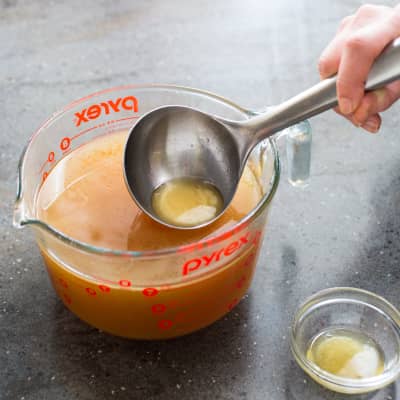1. Set up your cutting board
You don’t need to have a butcher block, but your board should be sturdy and unwarped and it should sit stably on your counter. You don’t want it to slide around while you’re operating heavy cutlery. (We like to use a wet dish towel or a gripper mat underneath the board to ensure that it stays glued to the counter.)
2. Choose your plan of attack
Depending on the type of food and what you’re trying to do with it, you’ll want to use the cleaver in different ways. It’s not always best to hack; sometimes it makes more sense to use the knife’s weight and leverage to carefully slice or split food open instead. For example, if you’re halving a whole roast duck, you can use the cleaver as you would a chef’s knife, employing a pinch grip and using a slight rocking motion to lever through the food.

Chopping poultry or meat, however, is a different matter. Put the poultry or meat you want to chop on the cutting board. If it’s a relatively long shape, such as a rib or a backbone, you can stabilize the end with your nondominant hand. Otherwise, make sure your hand is well out of chopping range. You might even want to keep this hand behind your back so you’re not tempted to put it in harm’s way.
3. When chopping poultry or meat, use a power grip on the cleaver
Wrap your fingers around the handle as if you were shaking hands with it. For added power and guidance, you can put your thumb on the spine of the knife—a tip we learned from Michael Dulock, one of the butchers we consulted for our review of meat cleavers—though this requires a little extra hand strength.
4. Get ready, then cut
There’s no need to wind up and make a big, dramatic hacking gesture with your arm. Instead, let the weight of the cleaver do much of the work for you. The chopping motion itself should come from your wrist. Raise your arm slightly from the elbow and then bring it down on the food, using your wrist to direct the knife and apply force. Dulock recommends trying to hit the food with the top third of the blade so that you can summon extra lever power if you don’t make it all the way through.
If you’re using a wood cutting board with a one-way grain, make sure to cut perpendicular to or at a slight angle to the grain—otherwise you risk splitting the cutting board when you chop.

5. Slice through a second time, if needed
It may take a little practice to gauge just how much force you need to supplement the cleaver’s weight. Hopefully, you’ve applied just the right amount to split the food with a clean cut, but it’s fine if you need to slice through the last remaining bits of meat or poultry. If the cleaver gets stuck halfway through the bone, place your nondominant hand on the spine of the knife and apply pressure to drive the knife downward and finish the cut. You can try to hack through the same spot twice, but it’s difficult to land on the exact target again, so you may end up with mangled meat.
If the cleaved food is small enough, you can now use the flat of the cleaver to lift it off the cutting board and into your stock pot or other cooking vessel. Just make sure not to drag the edge of the blade against the board, as this can dull it.
More from Cook's Illustrated

The Best Meat Cleavers
Traditional meat cleavers are built like medieval weapons. Could we find one fit for modern life?
Read Our Review
The Best Heavy-Duty Cutting Boards
A good wood or bamboo cutting board can serve you well for years to come. Which model is best?
Read Our Review
Manual Knife Sharpeners
Can a compact, inexpensive tool keep your kitchen knives in top shape?
Read Our Review
Quick Homemade Chicken Stock
Browning, sweating, and simmering small pieces of chopped chicken ekes out remarkably rich flavor in a little over an hour.
Get the Recipe
Simple Turkey Stock
We take a simple approach to stock making that delivers pure turkey flavor with very little effort.
Get the Recipe
Turkey Rice Soup with Mushrooms and Swiss Chard
No one wants to toil over turkey stock on the day after Thanksgiving. But what if you had a recipe that practically made itself?
Get the Recipe
Turkey Barley Soup
No one wants to toil over turkey stock on the day after Thanksgiving. But what if you had a recipe that practically made itself?
Get the Recipe
